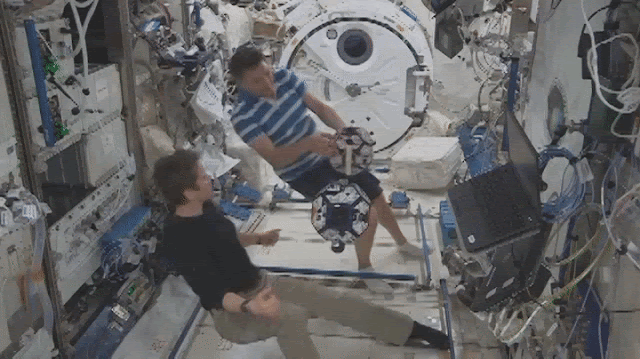mercredi 23 janvier 2019
Space Station Science Highlights: Week of January 14, 2019
ISS - Expedition 58 Mission patch.
Jan. 23, 2019
The SpaceX Dragon cargo craft is back on Earth after splashing down in the Pacific Ocean Sunday night, loaded with critical space research and International Space Station hardware.
Image above: The SpaceX Dragon departed from the orbiting lab and splashed down in the Pacific Ocean on Sunday, loaded with science and hardware. Image Credit: NASA.
Last week, the three-member Expedition 58 crew is conducting a wide array of microgravity science to improve life for humans on Earth and in space. Here’s a look at some of what they studied last week aboard the orbiting lab:
Robotics dry run conducted in preparation for high school competition
Synchronized Position Hold, Engage, Reorient, Experimental Satellites (SPHERES), three free-flying, bowling-ball sized spherical satellites used inside the space station to test a set of well-defined instructions for spacecraft performing autonomous rendezvous and docking maneuvers, are used for a variety of investigations aboard the space station.
The SPHERES-Zero-Robotics investigation provides an opportunity for high school students to conduct research aboard the station. As part of a competition, students write algorithms for the satellites to accomplish tasks relevant to potential future missions. The most promising designs are selected to operate the SPHERES satellites aboard the orbiting laboratory as a part of the competition.
Animation above: NASA astronaut Anne McClain and Oleg Kononenko of Roscomos conduct dry runs using the SPHERES satellites. Image Credit: NASA.
The crew performed a dry run in preparation for a high school tournament, currently planned for late January. The dry run is performed prior to the competition and allows ground controls to verify various aspects of the competition are working as intended. During the actual competition later this month, the teams will be tasked with completing a mock-scenario-- dodging virtual space debris in low-Earth orbit to retrieve a damaged SPHERES satellite.
Crew members measure changes in fluids within the body
More than half of American astronauts experience vision changes and anatomical alterations to parts of their eyes during and after long-duration spaceflight. It is thought that the headward fluid shift that occurs during space flight leads to increased pressure in the brain, which may push on the back of the eye, causing it to change shape. The Fluid Shifts investigation measures how much fluid shifts from the lower body to the upper body, in or out of cells and blood vessels, and determines the impact these shifts have on fluid pressure in the head, changes in vision and eye structures.
The crew performed the dilution measures portion of the ongoing Fluid Shifts investigation. This involves the ingestion of a tracer solution and collection of blood, saliva and urine samples. Additionally, the crew performed baseline for the investigation. Baseline imaging uses various hardware to measure a multitude of anatomical and physiological data points including arterial and venous measures of head and neck, tissue thickness of lower and upper body, ocular structure and more.
Radiation levels tested aboard station
The RaDI-N2 Neutron Field Study (Radi-N2) measures neutron radiation levels aboard the orbiting laboratory using Space Bubble Detectors. Results from this investigation may provide a better understanding of the connections between neutron radiation and DNA damage and mutation rates, symptoms that affect some astronauts, and other radiation health issues on Earth.
Image above: CSA astronaut David Saint-Jacques deployed radiation detectors as a part of the Radi-N2 investigation. Image Credit: Canadian Space Agency.
The crew deployed all eight detectors into the Tranquility module rack area and took photos of the deployed detectors.
Other work was performed on these investigations:
- Bio-Monitor performs on-orbit quantification of biological molecules and their cellular composition in samples collected, and prepared, on board the space station: https://www.nasa.gov/mission_pages/station/research/experiments/explorer/Facility.html?#id=7392
- The Electrostatic Levitation Furnace (ELF) is an experimental facility designed to levitate, melt and solidify materials by container-less processing techniques using the electrostatic levitation method: https://www.nasa.gov/mission_pages/station/research/experiments/explorer/Investigation.html?#id=1738
- Behavioral Core Measures examines an integrated, standardized suite of measurements for its ability to rapidly and reliably assess the risk of adverse cognitive or behavioral conditions and psychiatric disorders during long-duration spaceflight: https://www.nasa.gov/mission_pages/station/research/experiments/explorer/Investigation.html?#id=7537
- Team Task Switching studies whether or not crew members have difficulty in switching tasks and determines the impacts of these switches in order to both reduce any negative consequences and improve individual and team motivation and effectiveness: https://www.nasa.gov/mission_pages/station/research/experiments/explorer/Investigation.html?#id=7538
- The MELFI is a cold storage unit that maintains experiment samples at ultra-cold temperatures throughout a mission: https://www.nasa.gov/mission_pages/station/research/experiments/explorer/Facility.html?#id=56
- Kubik is a small controlled-temperature incubator or cooler with removable inserts designed for self-contained, automatic microgravity experiments such as those using seeds, cells, and small animals: https://www.nasa.gov/mission_pages/station/research/experiments/explorer/Facility.html?#id=894
- SlingShot is a small satellite deployment system that can accommodate up to 18 satellites: https://www.nasa.gov/mission_pages/station/research/experiments/explorer/Facility.html?#id=7847
- LMM Biophysics 5 tests whether solution convection – movement of molecules through the fluid – enhances or suppresses formation of the dense liquid clusters from which crystals form: https://www.nasa.gov/mission_pages/station/research/experiments/explorer/Investigation.html?#id=7742
Related links:
Expedition 58: https://www.nasa.gov/mission_pages/station/expeditions/expedition58/index.html
SPHERES: https://www.nasa.gov/mission_pages/station/research/experiments/explorer/Investigation.html?#id=303
SPHERES-Zero-Robotics: https://www.nasa.gov/mission_pages/station/research/experiments/explorer/Investigation.html?#id=679
Fluid Shifts: https://www.nasa.gov/mission_pages/station/research/experiments/explorer/Investigation.html?#id=1126
Radi-N2: https://www.nasa.gov/mission_pages/station/research/experiments/explorer/Investigation.html?#id=874
Space Bubble Detectors: http://www.asc-csa.gc.ca/eng/sciences/osm/detector.asp
Space Station Research and Technology: https://www.nasa.gov/mission_pages/station/research/index.html
International Space Station (ISS): https://www.nasa.gov/mission_pages/station/main/index.html
Images (mentioned), Animation (mentioned), Text, Credits: NASA/Michael Johnson/Vic Cooley, Lead Increment Scientist Expeditions 57/58.
Best regards, Orbiter.ch




